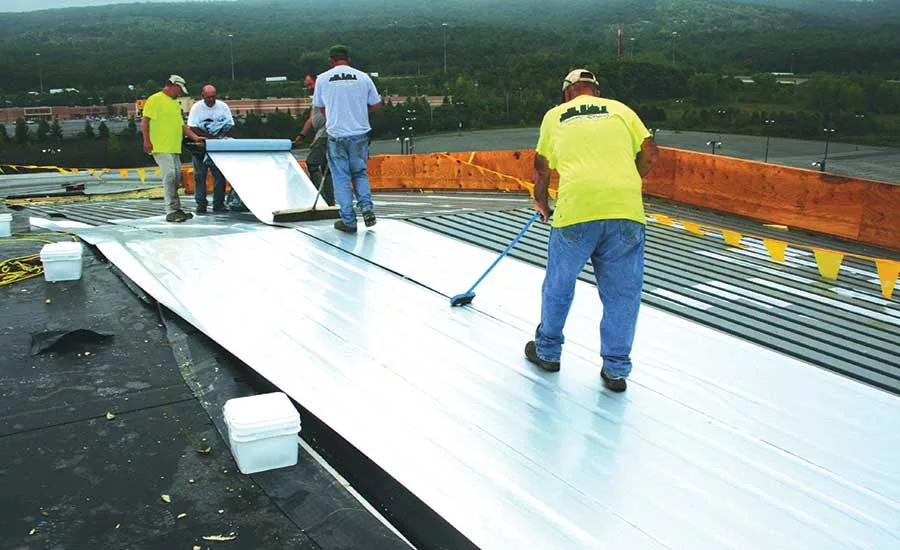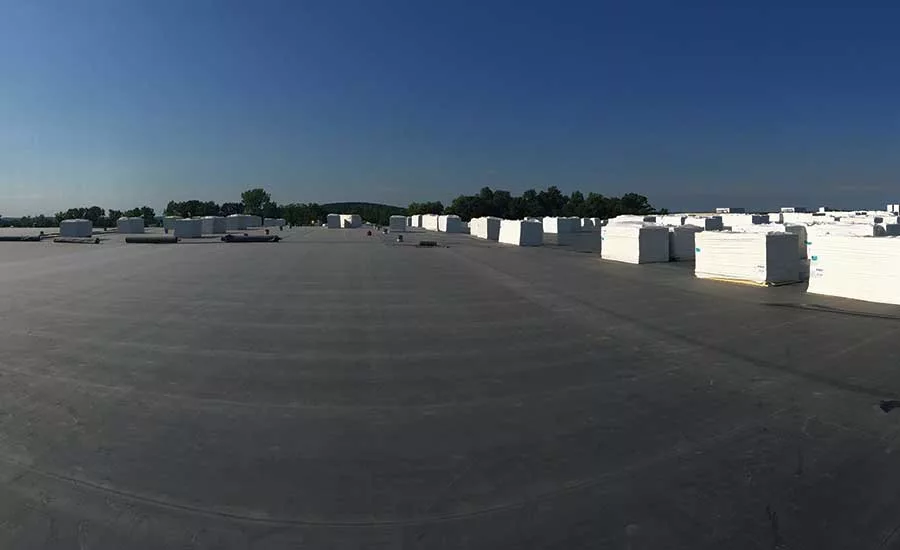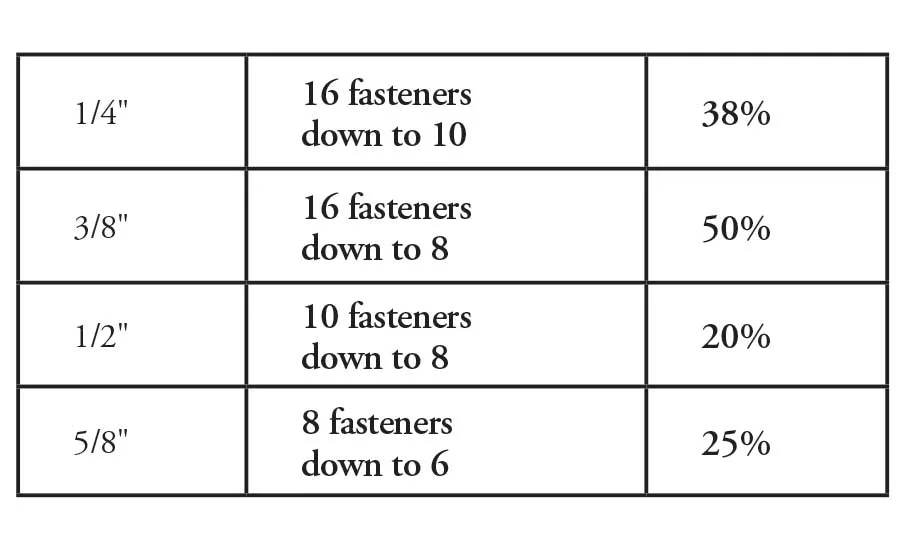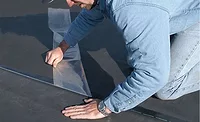Productivity on the Rooftop has Never Been More Important on EPDM Installations
Big Boost



One of the major challenges facing roofing contractors today is a shortage of skilled labor that limits the number of projects they can complete in a given year. If contractors are unable to grow their business by finding qualified employees, the next best strategy for growth is to improve the productivity of their existing crews. Choosing to use labor-saving products is a practical way to boost crews’ productivity and allow them to complete more projects in less time. For EPDM roofing systems, a number of productivity-enhancing products are available which can significantly improve efficiency.
Membranes
Using EPDM with pre-applied seam tape eliminates the need to prime one edge of the membrane, as well as the need to place the tape — saving significant time. In addition, since the tape is applied in a factory-controlled setting, the quality of the seam is enhanced.
Wide-width EPDM sheets can dramatically reduce the number of seams in the roofing system. For adhered projects, utilizing 20’-, 25’-, or 30’-wide folded sheets with pre-applied tape is a great productivity booster. For projects that are more congested, 16.5’ no-fold sheets with pre-applied tape could be a solution. In each case, crews’ efficiency is improved.
Using pre-cleaned 10’-wide EPDM sheets means that primer can be roller-applied, as opposed to scrubbing it into the sheet with a Scotch-Brite™ pad. A lot less elbow grease is required when making seams with pre-cleaned membranes.
For mechanically fastened FM 1-90 projects into a standard steel deck, productivity can be increased by using 6.5’-wide sheets with pre-applied tape, which is more efficient than having to split a 10’ sheet with the installation of a 9”-wide reinforced securement strip.
Flashings
Pre-cut and pre-formed flashing accessories such as peel-and-stick corners, pockets, pipe boots, and t-joint covers are designed to make jobs easier and quicker to complete. These products provide significant labor savings by eliminating the need to measure and cut individual pieces of flashing to complete the roof details. Using peel-and-stick curb flashing also enhances productivity because there’s no need to apply bonding adhesive to both the curb and the membrane.
Adhesives and Sealants
Most solvent-based bonding adhesives must be applied to both the membrane and the substrate. Choosing to use a solvent-free adhesive allows for a one-sided application which cuts application time in half. In addition, the sheet can be installed while solvent-free adhesive is still wet, as opposed to waiting for solvents to flash off. Self-adhered or peel-and-stick membranes are also available; these products eliminate the need to apply bonding adhesive and to load bonding adhesive onto the roof. Using a one-component pourable sealer in lieu of a two-component product can also provide labor savings, as mixing is eliminated.
Cover Boards
The number of fasteners required to meet a desired uplift pressure can vary greatly from one cover board to another. For example, using select gypsum fiber roof boards with hexagonal insulation plates significantly reduces the number of fasteners required to achieve an FM 1-90 approval rating. The chart below demonstrates some of the fastener reductions that are possible.
A similar reduction in fasteners is possible when using select ½” high-density polyiso insulating cover boards that utilize a specially designed coated glass facer for use in fully adhered membrane applications. Using high-density polyiso cover boards with this optimized facer reduces the number of fasteners required for an FM 1-90 uplift approval rating by up to 50 percent.
Many contractors are migrating toward high-density polyiso insulating cover boards, as they’re much lighter and easier for crews to cut and handle. A ½” 4’ x 8’ high-density polyiso cover board weighs 11 pounds, compared to 64 (or more) pounds for a ½” 4’ x 8’ gypsum-based cover board. Crews can carry several pieces of high-density polyiso cover board at a time, resulting in fewer trips across the roof.
Fasteners
Reducing the number of fasteners in the system is one way to significantly increase productivity. Pre-assembled fasteners and plates allow workers to install two items at once, as opposed to purchasing, transporting and installing them separately.
When pre-assembled fasteners and plates aren’t used, automated stand-up fastening tools are a great way to enhance productivity and reduce worker fatigue caused by bending over to install fasteners and plates.
Insulation Adhesives
Two-component insulation adhesives are very popular because they tend to set up and hold much more quickly than single-component insulation adhesives. The greatest productivity advantage offered by two-component insulation adhesives is eliminating the laborious step of pre-drilling on specialty deck types like structural concrete or gypsum. A wide variety of application equipment is available for two-component insulation adhesives, some of which have a rated output of two gallons per minute, along with heated hose lines that allow for cold-weather applications.
Vapor Barriers
A number of labor-saving peel-and-stick air and vapor barriers are available. Productivity can be further enhanced by using a spray-applied primer. Solvent-based primers are generally roller-applied and require up to an hour or more of flash-off time prior to setting the vapor barrier. Spray-applied primers, on the other hand, are less time consuming to install and can flash-off in less than five minutes.
The use of air and vapor barriers is steadily gaining popularity, particularly in mechanically fastened roof systems. Air and vapor barriers reduce the potential for condensation-related issues — especially in systems with white or light-colored membranes — and are a requirement of the IECC energy code in many parts of the United States. Mechanically fastened systems over steel decks are quite popular, and selecting an air and vapor barrier that can be applied directly to a metal deck — while meeting the internal fire codes — can dramatically improve productivity. Most air and vapor barriers have to be installed over a base layer of gypsum board which must be primed prior to installing the air and vapor barrier.
Metal Edging
Finishing off a project with a labor-saving metal edge design is the final piece of the productivity puzzle. With most shop-fabricated metal edges, the flanges must be fastened into perimeter blocking and stripped-in using primer and peel-and-stick flashing. However, many engineered metal edging systems use a snap-on installation method that eliminates the need for stripping in a flange. This saves time and money and often dramatically improves the uplift resistance around the roof perimeter.
Finish More in Less Time
In closing, when the heat is on to complete projects as quickly as possible — to satisfy a client’s demanding schedule or just get more projects completed each year with existing crews — it’s important to take advantage of product innovations designed to increase productivity. Labor-saving products allow contractors to complete more projects in less time and increase revenue without adding employees.
Looking for a reprint of this article?
From high-res PDFs to custom plaques, order your copy today!




.webp?height=200&t=1651783959&width=200)
